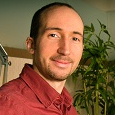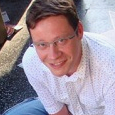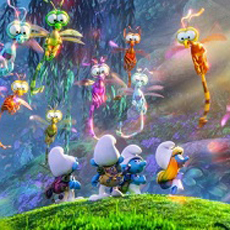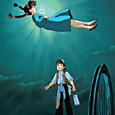David Couchariere is originally from Belgium, he’s been a 3D character animator for DreamWorks Animation for over five years now, where he worked on How To Train Your Dragon, Madagascar 2, Kung-Fu Panda, and Flushed Away. Prior to that, he worked for Blue Sky Studios in New-York on Ice Age 2 and Robots. Before that, he worked on three European animated features: an animated professional journey about which we spoke with the artist himself.
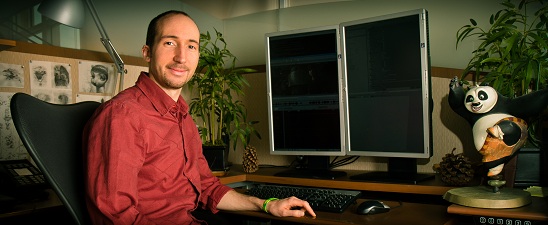
Animated Views: Can you tell me about your training?
David Couchariere: Around the age of 19, for the first time, I seriously considered animation as a career and spontaneously applied to various schools but failed miserably because I didn’t have the required entry level ! So I decided to spend one year learning on my own to improve my skills. It was a pretty hard year, I was just hanging in there, striving to gain knowledge from books and practice in the hope that I would get good enough to enter a school the following year. It paid off, I learned a lot and ended up going to the Brussels Royal Academy of Fine Arts then to an animation school in Luxembourg, the Technical School of Crafts and Arts where I got my animation degree.
AV: What interested you in CG animation?
DC: I was trained in 2D, then 3D. So the speed of animation feedback in CG was appealing to me from the start. You could set a couple of key poses, shoot a preview and have something moving in front of you in a matter of seconds. No need to go back over 50 drawings to make tweaks and corrections. However, I must admit I miss drawing sometimes, the direct contact of pencil on paper, even though I still get to play with visual aesthetics when I sculpt the shape of a pose in 3D, only with a different tool
AV: How did you come from Belgium to the US?
DC: After getting my degree, I was directly hired by Oniria Pictures, a studio in Luxembourg for which I worked on my two first animated feature films as an animator (Tristan and Isolde and Renart The Fox). I learned 3D Studio Max and Character Studio. Then I moved to France to work on another feature, Doogal, The Magic Roundabout on Softimage XSI. One year later, I decided to send a reel to Blue Sky Studios. They contacted me a few weeks later, they sent me an animation test that I did over the course of about a week. When I sent it back, they flew me over to New-York to meet and made me an offer. Three months later, I was moving with my wife to White Plains, NY, where the studio used to be. I contributed to two movies with them: Robots and Ice Age: The Meltdown. Later, I ended up at Dreamworks, where I have been working ever since.

AV: You worked for Blue Sky and Dreamworks. What are the differences between the two as Studios regarding their vision of animation, the process and the working atmosphere?
DC: The founders of Blue Sky had already set a foot in CG animation for a while. Chris Wedge had worked on Tron back in the old days. That was very interesting, and he was a real driving force with Carlos Saldanha over there. Also, everyone in the studio concentrated on one movie at a time, which created a specific sort of emulation.
Before the 3D era, Dreamworks had a long history of 2D expertise with old timers such as James Baxter or Kristof Serrand. Learning from that type of environment was full of new insights for me as well. The studio being bigger, different teams are working on different movies at the same time, so you get constantly inspired by very different work styles, and after finishing on a project, you jump on another one right away.
In terms of atmosphere, both studios felt to me like a sanctuary of people very passionate about their craft, and like few places on Earth where geeks can actually be superstars!
AV: Would you please tell us about your experience and challenges on the different movies you worked on?
DC: Robots was a fantastic project and, in my own journey of growing as an animator, clearly my trial by fire. It was my first experience on a project of that scale at the time. I remember watching the work in progress of the movie on my starting day, and being both incredibly inspired and simultaneously terrified by the challenge of meeting that degree of animation quality on an everyday basis. That project alone got me through a tremendous learning curve. I witnessed how other animators worked, how production was organized. Even having dailies everyday was a new thing for me. I learned a lot about the craft from some supervisors over there and a couple of animators.
The challenge on that project was to strike the right balance between robotic and organic appearance, mostly in the face. For example, over-shaping the mouth or loosening the face too much sometimes looked to human-like and we had to pull back. It had to look a little “raw”, but subtle enough to cover the entire spectrum of human emotions. All the pupils had to be cheated to camera on most shots, as they were flat discs that could literally disappear in a profile view.
Working with Chris Wedge and Carlos Saldanha was a real pleasure. They were both very inspiring, energetic and complementary. They were clearly trying to push the visual envelope with that universe, which I believe has some superb production design work. My most challenging scene was probably a shot of the bad guy getting stuck in a line of several characters dancing together. My favorite scene was a subtle acting scene where Rodney, the hero, is sitting in a chair pouring some hot oil down his back to relax after a hard day.
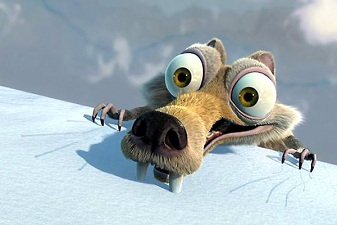
Now, about Ice Age 2: the Meltdown, I was very excited at the idea of working on that project because I loved the first episode in theaters, and getting to touch these already famous characters was a little bit like a dream come true.
After a year of working on robotic characters, the challenge to me was now to transition to organic characters, with flesh and bones and fat in between, and get it all to feel natural. The fur too, was an important element to keep in mind when animating contacts. And it’s the first time I got to animate fish as well, which is an adventure of its own altogether.
Carlos Saldanha was directing, so I was sailing in familiar waters there. Plus he already knew the world and characters inside out from the first episode, which made it even easier and very streamlined in terms of direction.
My most challenging scene was probably the female mammoth lying on her back and rolling over to stand back up, helped by two possums. It sounds like nothing, but everything was in for the nightmare: unlikely action in real life, constraints, hair, ground penetrations, cheating shapes and geometry, scaling limbs, heavy rig and choreography of all the characters around the same action.
My favorite shot in terms of result was either that very one, which I was quite happy with in the end, or an acting shot of Sid talking to Diego about his fear of water, throwing a rock over his shoulder into a pond in the background.
On Kung Fu Panda, I was in love with the production design of Panda from the moment I saw it, so I was delighted at the idea of working on that movie. The challenge on that one was obvious: Kung Fu. In order to reproduce any movement in a believable fashion, we needed to understand it to a large degree, which meant learning some martial arts basics. We had Kung Fu and Tai chi classes on campus and in the parking lot, we watched a lot of martial art classic movies, and some animators, including supervisor Rodolphe Guenoden (who choreographed most of the fighting sequences), had an in-depth knowledge of martial arts disciplines, which was a great help.
I worked mostly with one of the two directors, Mark Osborne, who was unbelievably easy to approach, communicate with, and basically work with. There was a keen sense of camaraderie on that movie which I really enjoyed. Two very challenging scenes come to mind: one was a kung fu shot of Tai Lung and Tigress fighting on the suspended bridge. There was some intense choreography, constraints, and a big camera move as Tai Lung grabbed Tigress’s foot and pulled her out through the bridge and into the air. The other one was a long acting shot with lots of characters when Po gets chosen as Dragon Warrior, where Shifu walks along Oogway trying to convince his master he just made a terrible mistake. Lots of characters and staging choreography as Po was taken away by a bunch of geese.
A scene I really like is an acting shot of Shifu confronting Po as he’s trying to leave, trying to convince his own self that he can turn Po into the Dragon Warrior. There was an interesting emotional complexity to that shot.
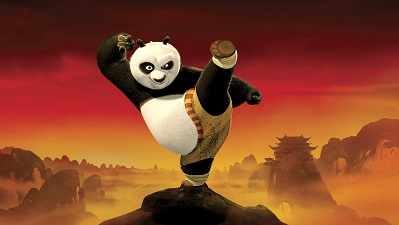
How to Train your Dragon was just a fantastic project. Story, production design, animation, lighting style, everything. The main challenge was to portray believable dragons. When you think about it, you are talking about four-legged characters with a set of wings and a long tail, and sometimes a long neck too. That’s a lot of stuff for just one character ! Plus, you have to make them fly, which is no piece of cake either. Simon Otto, the Head of Animation on the movie, designed a three weeks “flight school” program that every animator had to go through, where we learned the mechanics of bird flight, take off and landing.
I personally had very few dragon shots. The reason is the production schedule was fairly short, so a small group of animators was assigned to each character to quickly create “experts” who would grow to know both the rig and animation style of that particular character inside out. I was assigned to Hiccup (the hero), Stoick (his dad), and Gobber (his mentor).
Because these characters were humans, we started filming ourselves a lot and studying a lot of live-action reference. Working with Chris Sanders and Dean Deblois was like working with the perfect couple of directors. They were very complementary and had such a strong grasp on the story from the start that it made the animation process particularly straight forward.
My most challenging scene was oddly one of my shortest scenes: when Hiccup releases Toothless at the beginning of the movie, the dragon jumps on him right away and pins him against a rock. The wide shot where the dragon jumps had to be cheated graphically because there wasn’t enough actual space between the starting position and the rock for the dragon to make such a big leap. So it took a lot of cheat and graphic design thinking.
The shot I am probably most happy about is Stoick walking around in the midst of the final explosion of the movie, desperately looking for his son. It involved a lot of mechanics of movement which were very fun to animate.
AV: What led you to working with Dreamworks in particular?
DC: I really wanted to work on Kung Fu Panda. After seeing an early image of Po in the press a couple of years ago, I just fell in love with the style and subject matter. I submitted a reel. They liked it, called me back, and made me an offer. I have been working at Dreamworks ever since.
AV: On Robots, how did you deal with the characters’ animation?
DC: We didn’t want to limit ourselves in terms of overall motion. The robots were actually all fully animated from head to toe with a strong attention to detail. It’s only when it came to the facials that we tried not to make it look too fleshy or organic, yet believable. We played with the face in many different ways, but always trying to keep the sense that it was made of a bunch of mechanical parts.
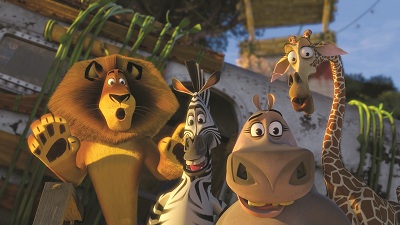
AV: You animated plenty of animals, from the ones of Ice Age 2 to the ones of Madagascar 2and Kung Fu Panda. How did you approach that kind of animation?
DC: We made trips to the zoo, watched a lot of live animal footage frame by frame in order to get a firm grasp on the feel of the animals, the mechanics of movement, to understand which poses made them look natural. Then, in order for the audience to invest in these specific types of character, the core of your animation often has to be based on human behavior. So, that’s where you start mixing stuff : you take a head tilt or a human attitude and you try to apply it on the locomotion of a four-legged animal, or you throw in something funky and animal-like using Sid’s neck while he’s delivering a rather human-like performance, Oogway in Kung Fu Panda moves very slowly because he’s a turtle but some of his idiosyncrasies are rooted in the reality of an old human being, etc … You just keep an eye open for these little things that speak loud and say “this is very much like this animal” and at the same time throw in a bit of “I have already seen my friend, sister, or neighbor behave this way”.
Now when it comes to movies like Madagascar, you are of course adding a strong element of animation stylization where you are sometimes basically throwing reality on its head, bending and twisting the laws of physics, and going very wide in terms of emotional range.
AV: I loved Kung Fu Panda because, whereas I found the other Dreamworks movies more script/dialog-oriented, I found it was more animation-oriented. Do you agree?
DC: I am not sure that Panda was necessarily less script oriented in the sense that the heart of the movie mainly came from the underlying support of a very strong archetypal storyline and empathetic characters which animation is ultimately there to serve. However, you are right, we were tapping into a sub-genre that naturally lends itself to slapstick comedy and physical action, which indeed tends to present animation performance center stage up close and personal. So yes, it was definitely a very fun and unique experience to animate in that realm and offered very interesting and pleasing possibilities !

AV: How do you animate?
DC: I usually spend a considerable amount of time researching, from life whenever possible, before I start on a new shot or a new movie. I watch a lot of live action footage frame by frame, I make sketches, I film my self or act out my scene in front of a mirror up until the point where I know exactly what I want to portray and fully understand the mechanics involved in the action. It can be time consuming, but in the end, I gain time because I don’t have to redo a bunch of stuff down the line. Depending on the animation style of the movie, I will have to transpose that research by adopting either a very realistic style, a more caricatured style, or a mix of both that might require both a certain amount of realism and a touch of graphic abstraction. Then, I start animating pose to pose, I break down my movements, and when it’s solid enough, I start making straight ahead passes on every element one a a time until I am happy with the result.
In terms of organization, the productions I worked on have navigated between a one animator per shot philosophy and a couple of animators per character approach, most of the time mixing both to a degree. So, you may end up having to animate all the characters yourself, or share the shot with someone else, if for instance it’s a really big shot with two main characters that some specific animators have both become real experts at dealing with. In the latter case, any interactions can only be handled through good old fashion communication and planning. If we use a lot of reference footage, filming ourselves, sometimes a couple of people do develop a certain affinity of style with one character and can naturally act it out physically in front of the camera. These types of things are pretty unpredictable too, so it is always a mixture of planning and following the flow.
The input of the director is always of major importance. It’s the person who ultimately launches you on the shot and validates it in the end. So the animator is absolutely always at the service of the director’s own individual vision. To answer your last question, as an example of inspiration, I was very pleased with my collaboration with Chris Sanders and Dean Deblois. They were always extremely clear and thorough about the story point they wanted to convey in a shot while leaving me a range of freedom in terms of execution.
AV: When you animate, the characters are often very rough and robotic. Is it more difficult to give the illusion of life in those conditions?
DC: It’s mostly a question of following through with the process. It is interesting because, to me, it always felt like 3D and 2D were very similar at their most basic level, yet fairly opposed in terms of process in the early stages. In 2D, you often start with a very rough and spontaneous drawing, almost like an impression, a feeling, or something almost abstract, then you start to sculpt it to give it perspective, form, to make it 3-dimensional and believable, and what you sometimes loose a little bit in the process in terms of spontaneity, you gain in character modeling and believability.
In 3D, you start with a perfect model, perfectly 3 dimensional, and the more you progress through your work, the more it starts to gain the spontaneity and flow it lacks in the beginning, until it finally gets a life of its own. So at the beginning, you may feel like there is a long road ahead, but it changes much faster than you’d think, and once it starts to feel alive, the possibilities with the computer become almost endless.

AV: Who are your masters in terms of animation?
DC: Some artists that come to mind, just to name a few, because there is a long list in my head: James Baxter, Kristof Serrand, Rodolphe Guenoden, Glen Keane, Andreas Deja, Eric Goldberg, Richard Williams, Claire Wendling, Nicolat Marlet, and a long list of Japanese artists including of course Miyazaki. To me, they all reached the top when it comes to mastering their craft, be it in terms of animation performance, acting sensibility, drawing proficiency and maturity, understanding of the visual language or plain storytelling.
AV: Do you consider hand drawn animation and CG animation separated or do you consider certain connections, or complementarity between the two?
DC: I certainly believe that are complementary and don’t see any reason whey they couldn’t coexist as there are no inherent issues with any of these media. It’s more about trends that are being followed and about whether or not they fit the subject matter of a particular project they are being used for. There are some things that are much easier and much harder to achieve with each one, and it’s part of what gives them their particular charm. Personally, I love both and to me, ultimately, they both come from the same place: storytelling.
AV: Tangled tried to find a link between hand drawn and CG. What do you think about that approach?
DC: I liked it because I felt that particular approach suited that particular project, which might not necessarily have been the case with another. I am a firm believer that animation style should always serve the story as it is as much of a statement as production design or cinematography. So, I always enjoy seeing a specific animation touch as long as it is in line with the movie, which it was in that case.
AV: How do you see your professional journey?
DC: I feel lucky. Lucky that my parents supported me when I said I wanted to be an animator, that I entered a school and met people who inspired me, that I got a job in the industry and managed to grow personally to eventually end up in a studio like Dreamworks. I feel blessed that I get to come to work everyday to do something I am passionate about !

AV: What is now your ambition as an animator?
DC: I am just always looking to better myself. I love discovering new ways to approach the craft, new ideas or tools, and I mostly try to keep training my eye as much as I can regarding anything related to the visual medium altogether.
AV: How do you see the line-up Dreamworks has just revealed regarding their animated projects?
DC: I actually feel extremely fortunate to be a part of Dreamworks at this particular moment in time. I believe it has been generating an amazingly rich and varied slate of projects. It is very appealing to artists because, for one, the line up is so constant that you can hope for a rather long-term job security – extraordinary and invaluable thing these days – and for two, the scope and graphic style of the projects is very wide, so artistically speaking, you can experience that variety first hand. There are a lot of places where you don’t necessarily have that type of choice. For example, the graphic signature of Madagascar, Flushed Away, Kung-Fu Panda and How To Train Your Dragon are all very different. So I couldn’t be more pleased with where Dreamworks is at today.
Our thanks go to both Davids (Couchariere and Hail)!


